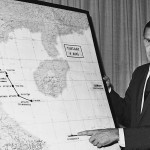Commemorating Three Pivotal Wars
This year Americans are commemorating all three of their most pivotal 20th-century conflicts. A century has passed since the start of World War I, 70 years since the D-Day landings, and this month marks the 50th anniversary of the Tonkin Gulf incident, which was used to justify American escalation in Vietnam.
But these are more than mere anniversaries. They are also reminders. Throughout none of those wars, or during America’s more recent conflicts in Afghanistan or Iraq, have American leaders truly grasped what drives their opponents. Tonkin stands as a symbol of that tragic truth.
To the extent they remember it all, most Americans recall that President Lyndon Johnson used the excuse of alleged hostile action by North Vietnamese ships on Aug. 2, 1964 against the U.S.S. Maddox, a destroyer patrolling in the Gulf of Tonkin, as a pretext for going to war. But there was much more to it than that. Even after five decades of scholarly study, historians are still struggling to comprehend Hanoi’s thinking at the time. The Maddox did patrol in North Vietnamese waters, and it reported being attacked on Aug. 2 and again on Aug.4. We now believe that the second alleged torpedo attack by North Vietnamese ships never happened, but the first torpedo strike was real. The question is why Hanoi attacked an American ship at all, since its policy had been to avoid a U.S. escalation. The last thing Hanoi wanted was to face a full-scale ground invasion, as this would severely hinder the communists’ hopes of uniting all of Vietnam. But the bigger puzzle is why Hanoi continued to sanction attacks against American bases for several months after Tonkin, when the risk of provoking the Americans was greatest.
Seeing the world through an enemy’s eyes is arguably the greatest challenge in any conflict. Most of us struggle to do it well. If Washington insiders at the time had tried to think like the North Vietnamese, they would have known that the fateful shots in Tonkin came just after two American strikes against Vietnamese targets. On the night of July 30-31, American ships shelled North Vietnamese islands. On Aug. 1 and Aug. 2, the United States conducted two bombing raids over Laos and North Vietnam. When North Vietnamese ships spotted the Maddox along their coast on Aug., their Navy’s High Command ordered them to shoot.
We do not know if American actions were intended to trigger a North Vietnamese retaliation, but from official Politburo records we can now see that Hanoi believed it was being deliberately provoked. On Aug. 7, the Politburo issued a directive entitled “Increasing Combat Readiness to Counter All Enemy Schemes to Commit Provocations and to Attack North Vietnam.” Hanoi expected America to intensify the war in the south and increase its assaults on the north. But if Hanoi feared such provocation, and if it wanted to avoid an American escalation, why did it continue attacking American bases?
Click here to view original web page at www.politico.com
Category: Anniversary




































